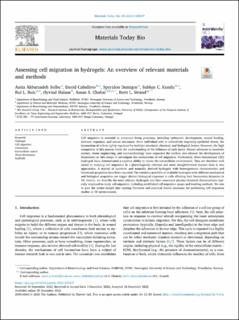| dc.contributor.author | Solbu, Anita Akbarzadeh | |
| dc.contributor.author | Caballero, David | |
| dc.contributor.author | Damigos, Spyridon | |
| dc.contributor.author | Kundu, Subhas | |
| dc.contributor.author | Reis, Rui L. | |
| dc.contributor.author | Halaas, Øyvind | |
| dc.contributor.author | Chahal, Aman Singh | |
| dc.contributor.author | Strand, Berit Løkensgard | |
| dc.date.accessioned | 2023-10-30T08:41:56Z | |
| dc.date.available | 2023-10-30T08:41:56Z | |
| dc.date.created | 2023-03-17T17:27:17Z | |
| dc.date.issued | 2023 | |
| dc.identifier.citation | Materials Today Bio. 2023, 18 . | en_US |
| dc.identifier.issn | 2590-0064 | |
| dc.identifier.uri | https://hdl.handle.net/11250/3099305 | |
| dc.description.abstract | Cell migration is essential in numerous living processes, including embryonic development, wound healing, immune responses, and cancer metastasis. From individual cells to collectively migrating epithelial sheets, the locomotion of cells is tightly regulated by multiple structural, chemical, and biological factors. However, the high complexity of this process limits the understanding of the influence of each factor. Recent advances in materials science, tissue engineering, and microtechnology have expanded the toolbox and allowed the development of biomimetic in vitro assays to investigate the mechanisms of cell migration. Particularly, three-dimensional (3D) hydrogels have demonstrated a superior ability to mimic the extracellular environment. They are therefore well suited to studying cell migration in a physiologically relevant and more straightforward manner than in vivo approaches. A myriad of synthetic and naturally derived hydrogels with heterogeneous characteristics and functional properties have been reported. The extensive portfolio of available hydrogels with different mechanical and biological properties can trigger distinct biological responses in cells affecting their locomotion dynamics in 3D. Herein, we describe the most relevant hydrogels and their associated physico-chemical characteristics typically employed to study cell migration, including established cell migration assays and tracking methods. We aim to give the reader insight into existing literature and practical details necessary for performing cell migration studies in 3D environments. | en_US |
| dc.language.iso | eng | en_US |
| dc.publisher | Elsevier | en_US |
| dc.rights | Navngivelse 4.0 Internasjonal | * |
| dc.rights.uri | http://creativecommons.org/licenses/by/4.0/deed.no | * |
| dc.title | Assessing cell migration in hydrogels: An overview of relevant materials and methods | en_US |
| dc.title.alternative | Assessing cell migration in hydrogels: An overview of relevant materials and methods | en_US |
| dc.type | Peer reviewed | en_US |
| dc.type | Journal article | en_US |
| dc.description.version | publishedVersion | en_US |
| dc.source.pagenumber | 14 | en_US |
| dc.source.volume | 18 | en_US |
| dc.source.journal | Materials Today Bio | en_US |
| dc.identifier.doi | 10.1016/j.mtbio.2022.100537 | |
| dc.identifier.cristin | 2134940 | |
| dc.relation.project | Norges forskningsråd: 269273 | en_US |
| cristin.ispublished | true | |
| cristin.qualitycode | 1 | |

